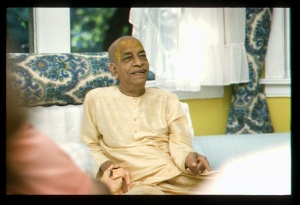CC Madhya 14.161 (1975)

A.C. Bhaktivedanta Swami Prabhupada
Below is the 1996 edition text, ready to be substituted with the 1975 one using the compile form.
TEXT 161
- vayase ‘madhyamā’ teṅho svabhāvete ‘samā’
- gāḍha prema-bhāve teṅho nirantara ‘vāmā’
SYNONYMS
vayase madhyamā—grown up; teṅho—Śrīmatī Rādhārāṇī; sva-bhāvete—in character; samā—equipoised; gāḍha—deep; prema-bhāve—in ecstatic love; teṅho—She; nirantara—constantly; vāmā—of the group of the left-wing gopīs.
TRANSLATION
“Rādhārāṇī is grown up, and Her character is equipoised. She is always deeply absorbed in ecstatic love and always feeling in the mood of a left-wing gopī.
PURPORT
The left wing and right wing of the gopīs has been explained by Rūpa Gosvāmī in his Ujjvala-nīlamaṇi (Sakhī-prakaraṇa 26 and 32). The left wing is described in this way:
- mana-grahe sadodyuktā tac-chaithilye ca kopanā
- abhedyā nāyake prāyaḥ krūrā vāmeti kīrtyate
“A gopī who is always eager to be jealously angered, who is very enthusiastic for that position, who immediately becomes angry when defeated, who is never under the control of a hero, and who always opposes Him is called a vāmā, or a left-wing gopī.” Śrīla Rūpa Gosvāmī describes the right-wing gopīs in this way:
- asahyā māna-nirbandhe nāyake yukta-vādinī
- sāmabhis tena bhedyā ca dakṣiṇā parikīrtitā
“A gopī who cannot tolerate womanly anger, who speaks suitable words to the hero, and who is satisfied by His sweet words is called a dakṣiṇā, or a right-wing gopī.”